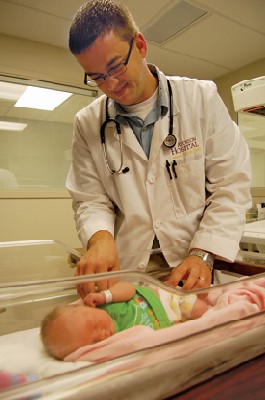Targeting rural health scholars keeps doctors in Kansas
Small-town practice has appeal to physicians who were born and raised in such communities. The Scholars in Rural Health program seeks to expose medical students to underserved areas, nurture a desire to practice primary care and offer incentives such as loan forgiveness.
When Aaron Sinclair, MD, was a medical student, his choice for setting up a medical practice was “anywhere but Atchison,” his Kansas hometown.
Three years after completing his residency, however, Dr. Sinclair is thriving as a family physician in the town where he was born, a rural community of about 10,000 people.

“By the time I finished residency I had three children. My family and my wife's family are from Atchison, and we didn't want to stray too far,” he said.
While family roots led him back to Atchison, he said, it was the rich variety of medical needs there that attracted him to stay.
Medically underserved counties
Dr. Sinclair is the type of doctor that the Scholars in Rural Health program, University of Kansas School of Medicine–Wichita and the state have worked hard to recruit, nurture, train and keep. The shortage of primary care physicians in most of Kansas' 105 counties, coupled with the state's recognition that most of its rural counties are medically underserved, prompted action that all involved hope will pay off with more medical students choosing primary care and returning to their small-town Kansas roots.
The medical school's Scholars in Rural Health program identifies promising potential medical students during their freshman and sophomore years of undergraduate coursework. To qualify for the program, the student must be a Kansas resident, have a good academic record and have significant experience living in a rural community.
Director K. James Kallail, PhD, a professor of internal medicine at the medical school, said that these undergraduates “shadow” a rural doctor at least 40 hours each semester as well as during the summer months between their junior and senior years, and they complete a case report each semester and a project by the end of the program. If all goes well and the student continues to excel in class work, their acceptance into the university's medical school is assured.
The state steps in with two loan programs, if needed, during medical school and residency: the Kansas Medical Student Loan and the Kansas Bridging Plan. Each helps with medical school expenses and gives loans that will be forgiven when the physician has practiced a primary care specialty within an underserved county for four years. Physicians must practice one year in a designated community for each year of the loan.
Barely meeting the need
According to Garold O. Minns, FACP, professor and program director in the department of internal medicine at the medical school, Kansas shares with the rest of the country a shortage of primary care specialists.
“We are concerned about where we are today because we are just barely meeting the needs for rural Kansas. The pipeline of doctors is not as full as we would like it to be for the future,” he said.
Three years ago, Dr. Kallail reported in “Educating General Internists for Kansas,” (Kansas Journal of Medicine. 2007;1(1):2-6) that the demand for general internists was expected to increase 20% by 2020, at a time when the university's own medical school was seeing a declining interest in primary care. In general, medical students are less interested in primary care because of the income disparity between what a primary care physician can make compared with a specialist, awareness that the reimbursement system favors procedural skills and quantity over quality, and frustration with inadequate reimbursement for generalists.
The effect of the scholars program on easing the shortage seems promising. Since 1997, 42 students have graduated from medical school, 30 of whom matched with primary care. Nineteen of the 42 have now completed residency. Of those, 12 practice in a rural or smaller community in Kansas, four are on the faculty at the medical school, one practices in an indigent clinic, and another is practicing in a rural community just across the border in Oklahoma. “So the outcomes look pretty good so far,” Dr. Kallail said.
Relationships matter
Tara Neil, MD, a primary care practitioner in Abilene, Kansas, was a member of the inaugural group of undergraduates when the scholars program began in 1997. She grew up in Abilene Ft. Scott, a town of about 7,000 people, and returned there to be mentored by the father of a childhood friend. “That exposed me to family practice, the multigenerational families, and the part that a family physician can play in a community,” she said.
Dr. Neil completed her residency in Madison, Wisc., and then a fellowship in women's health at a clinic on the west side of Chicago where she gained experience with high-risk obstetric cases. She joined the rural practice in Abilene three years ago and has learned to expect and handle all kinds of medical problems.
“When you are a primary care doctor in a small town, you have to do everything. I was aware of what I would be called upon to do, so I had to seek out some things in training to be ready. In training, we had orthopedists, pulmonary critical care doctors, and everyone easily at our disposal. We don't have that here in Abilene. I deliver babies, do C-sections, handle a lot of difficult pediatric cases,” she said.
For Dr. Sinclair, the diverse needs of the patients who walk through the door of a family practice hooked him on primary care early in medical school.
“I never envisioned myself just doing one thing because I get bored fairly easily,” he said. “Right now I do a little of everything: outpatient surgery, C-sections, colonoscopies. And I deliver babies, work in the emergency department, and work in a community health clinic I started here in town.”
Dr. Neil noted that it takes a certain kind of personality to thrive in a small-town or rural environment. “Usually the practitioners who choose to stay in a rural community like what they do and have a little bit of comfort with the unknown at times. And they like the relationships they develop with patients, seeing grandparents of children they deliver, taking care of three generations at a time, seeing them in public, watching them grow,” she said. “That part has been surprising and has had a bigger impact on me than I thought it would.”
Ambassadors for primary care
Like Dr. Sinclair, who has mentored three students since his return to Atchison, Dr. Neil mentors aspiring undergraduates who are considering a future in rural Kansas. Shadowing a doctor in a town like Abilene “provides them a break from undergraduate science classes and gives them an idea of what medicine will be like, of how things can be balanced, and how they can work in a small community,” she said. “The more exposure medical students get to primary care as early as possible will greatly influence their decision to choose that specialty.”
“Once you get into your third or fourth year of medical school with exposure to surgeons, OB/GYNs and all these different rotations, you see specialties that are more hands-on, that seem more exciting and are procedure-based. That's what medical students like. They don't get to see the relationships and the satisfaction that they can get from patient relationships in primary care,” Dr. Neil said.
According to Dr. Minns, some medical students are concerned about the scope of practice of a primary care doctor, thinking it may be too broad. “Some are intimidated by the breadth of primary care and instead feel more comfortable going into a specialty area because it narrows down the scope of what they have to be involved in,” he said.
The university and the state are building a strong track record of developing programs that encourage students to stay in Kansas and practice rural family medicine. “But even with that, it's still a challenge to overcome the forces that are encouraging people not to do this track. We keep working at it; having the support of primary care practicing physicians in the state is very important,” Dr. Minns said.
Matching young undergraduates with rural primary care doctors through the scholars program is a major part of that effort. “It's tough to teach a person still in undergraduate school who has little to no medical background a whole lot about medicine, but you can teach them about the social aspects, how to treat patients, how to treat people in general, and about the working relationship with those around you,” Dr. Sinclair said.
“That's what I focus on, beyond the lifestyle of what they can expect in a small town: how to be a good physician, a team player, and a good person.”





